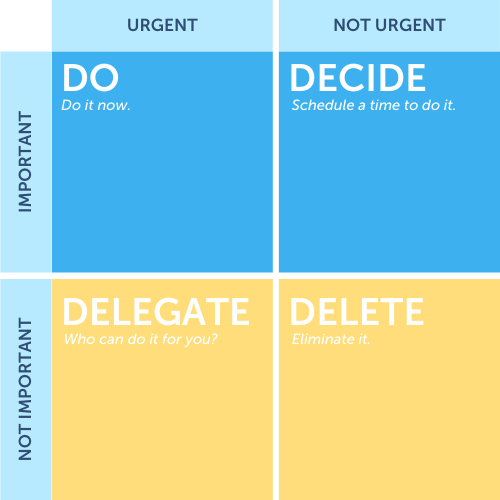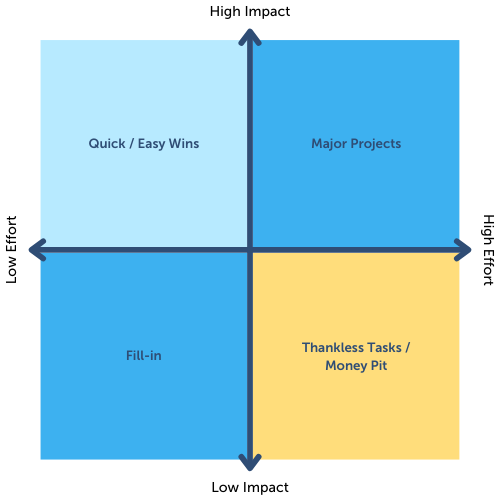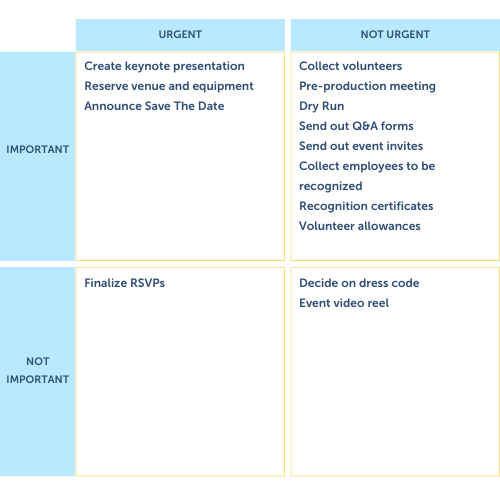Strategy and decision-making are valuable skill sets for project managers. 47% of Agile projects fail because of slow decision-making; and when there are so many things going on, where will you put your team’s energy?
Priority matrices are tools that structure decision-making and strategy in project management. Used well, seasoned and new project managers don’t have to rely on guesswork and intuition.
In this article, we’ll explore this valuable tool and discuss ways to maximize its utility for your projects.
What is a Priority Matrix?
A priority matrix is a tool used to evaluate and prioritize tasks or projects based on specific criteria, typically urgency, and importance. It helps individuals and teams make decisions by categorizing tasks into four quadrants:
- Urgent and Important: Tasks that need immediate attention and have significant consequences.
- Important but Not Urgent: Tasks that are crucial for long-term goals but do not require immediate action.
- Urgent but Not Important: Tasks that may seem pressing but do not contribute significantly to overall objectives.
- Neither Urgent nor Important: Tasks that can be postponed or delegated as they hold little value.
This framework aids in effective time management and resource allocation.
Importance of Prioritization in Project Management
When starting a project, it’s tempting to jump right at it and get the gears moving. Below are reasons why taking the time to identify relevant factors to consider and clarifying priorities can help make things smoother in the long run.
Stakeholder Alignment
Prioritization in project management plays a significant role in aligning stakeholders and ensuring a successful project outcome. Tools such as the priority matrix enable project managers to involve stakeholders in the prioritization process. This helps ensure that everyone is on the same page –promoting collaboration, enhancing communication, and ultimately leading to a more productive and harmonious project environment.
Project Team Alignment
When the project team has multiple tasks and deadlines to meet, it can be overwhelming. However, by using a priority matrix, the team can effectively prioritize their tasks and align their efforts toward the most important ones. This not only ensures that the project stays on track but also helps manage resources effectively.
By assigning priorities, everyone in the team knows what needs to be done first, eliminating confusion and enhancing collaboration.
Maximize Project Resources
Project managers can use a priority matrix to effectively identify and categorize tasks based on their importance and urgency. This helps manage the workload and ensures that project resources are maximized to their fullest potential.
By prioritizing critical tasks that require immediate attention, project managers can allocate resources efficiently and ensure that the project stays on track. This systematic approach helps optimize time, manpower, and financial resources, ultimately leading to successful project completion.
Key Components of a Priority Matrix
Factors to consider when defining priorities would vary based on several factors.
Urgency
Urgency in project management is the measure of how much a task or project requires immediate action to maximize opportunities. In digital marketing, for example, social media trends come in hard and fast. Social media managers maximize their relevance. Doing this successfully can potentially catapult brands to mass recognition.
By understanding the level of urgency, project managers can ensure that critical tasks are given priority and completed on time. Incorporating this metric into the priority matrix enables teams to stay focused and productive, resulting in successful project outcomes.
Importance
Another crucial component of a priority matrix is Importance. While not necessarily urgent, important tasks are those that provide strategic value. In marketing campaigns, these are marketing materials that may take time to create but would provide a significant impact on the business. Examples of these are company demo reels, long-form articles, and other deliverables that prioritize quality over quantity.
When you assign importance to tasks, you can determine if they’re worth allocating resources to, or if it’ll be better off to scrap them altogether in favor of more relevant efforts. By prioritizing tasks based on their importance, you can ensure that the most critical and impactful tasks are completed first, leading to the overall success of the business.
Others
Aside from urgency and importance, some companies and situations may require project managers to consider other factors such as stakeholder preference, effort level, and resource availability.
- Stakeholder Preference: Are there specific stakeholders whose opinions would have a major influence on the team’s success? What project areas matter to them?
- Effort Level: Are there low-hanging fruits that can be tackled?
- Resource Availability: Are there pieces of equipment or point persons that are only available for a limited time?
It can be argued that all these other factors can be considered to evaluate urgency and importance—and that can be correct. However, adding them (and other potential details) to the priority matrix needs to be assessed on a case-to-case basis.
Types of Priority Matrices
Priority matrices can be simple or complex. Below are some examples you can consider using for your next projects.
Eisenhower Matrix
An example of a simple priority matrix is the Eisenhower Matrix. It’s composed of four quadrants, where tasks are evaluated based on urgency and importance, and recommended actions are listed for each quadrant.

- Urgent and important: Do
- Not urgent but important: Schedule it to ensure it gets done
- Urgent and not important: Delegate if possible
- Not urgent and not important: Eliminate
By organizing project tasks on this matrix, project managers can create more effective project strategies to facilitate project success.
MoSCoW Method
MoSCoW stands for the categories to which project tasks can be classified in this prioritization model:
- Must have (M): Important tasks that need to be accomplished immediately
- Should have (S): Important tasks that don’t have strict time frames
- Could have (C): Tasks that can be done as long as they don’t affect other parts of the project negatively
- Won’t have (W): Nice-to-haves that can be done at a later time or later stage in the project
The MoSCoW Method is a fantastic tool for project management that can help you prioritize your tasks effectively. It’s simple to do, allowing it to be used with little friction.
Value vs Effort Matrix
The Value vs Effort Matrix allows you to prioritize tasks and projects based on their value and the effort required to complete them. It’s great for deciding which tasks will provide the most benefits while going over the resources that need to be used to complete them.

- High impact, low effort: Quick wins and definitely worth the effort
- High impact, high effort: Big projects that need to be tackled systematically
- Low effort, low impact: Can be done but only if situations are favorable
- Low impact high effort: Money pit, can potentially drain resources and not provide much return on investment
By using this matrix, you can make informed decisions about where to allocate your resources and ensure that you are maximizing your team's productivity. It also helps in identifying tasks that may require more effort but have low value, allowing you to either delegate them or find ways to streamline the process.
How to Make a Priority Matrix in Project Management
Identify Tasks or Projects
To get started with creating a priority matrix, the first step is to identify all the tasks or projects that you need to tackle. This could include work assignments, personal goals, or any other responsibilities that require your attention. By making a comprehensive list, you'll have a clear understanding of everything that needs to be done.
Identify Variables
Once you have your list of tasks or projects, it's time to identify the variables that you want to consider for your priority matrix. These variables can be anything that is important to you and will help you determine the order in which tasks should be completed.
For example, you may want to consider factors such as deadlines, level of effort required, or potential impact on your overall goals. By defining these variables, you'll have a framework to evaluate each task and assign it a priority level.
Categorize Tasks
Next, assess tasks based on the factors and plot them on the matrix. Consider using project management software for this, as physical priority matrices might not be as scalable for big projects.
Workamajig is a project management tool designed just for creative teams. It has robust project management and agency management features that can help streamline project processes and operations.
Benefits of Using a Priority Matrix in Project Management
Enhanced Decision-making
Using a priority matrix in project management can greatly enhance your decision-making process. It can allow you to focus your time and resources on the most critical aspects of your project, ensuring that you are making informed decisions that align with your overall goals and objectives.
With a priority matrix, you can easily identify high-priority tasks that require immediate attention, while also recognizing lower-priority tasks that can be deferred or delegated. This level of clarity and organization empowers you to make decisions with confidence, ultimately leading to increased efficiency and success in your project management endeavors.
Improved Time Management
A priority matrix allows you to categorize tasks based on their importance and urgency, helping you focus on the most critical ones first. This not only helps you stay organized but also ensures that you are utilizing your time efficiently.
With a clear understanding of what needs to be done and when you can avoid wasting time on less important tasks and instead dedicate your energy to completing high-priority items.
Increased Productivity
By clearly defining and prioritizing tasks in your project, team members can focus on the right things. A priority matrix helps to eliminate confusion and ensures everyone is working towards the same goals. A priority matrix can help project managers allocate manpower efficiently, ensuring that the right people are working on the right tasks at the right time. This not only saves time and effort but also increases overall productivity.
Better Resource Allocation
When managing a project, it is crucial to allocate resources effectively in order to maximize efficiency and productivity. The priority matrix allows project managers to allocate resources such as time, manpower, and budget to the tasks that require immediate attention.
By focusing on the most critical tasks first, resources can be allocated strategically, ensuring that the project progresses smoothly and efficiently. With better resource allocation, projects are more likely to be completed on time and within budget, resulting in higher satisfaction for both the project team and stakeholders.
Common Mistakes to Avoid in Making a Priority Matrix
Over-Complicating the Matrix
In project management, simplicity is often the key to success. One common mistake that many project managers make when creating a priority matrix is over-complicating it.
While including every possible factor and sub-factor in the matrix may be tempting, this can hinder the decision-making process. Instead, focus on the most critical factors that will impact the project's success.
By keeping the priority matrix simple, you can ensure that everyone involved in the project understands it and can make informed decisions based on it.
Ignoring Team Input
Many project managers make the common mistake of ignoring team input when creating this matrix. It is crucial to remember that your team members will be executing the tasks and completing the project. Their input and perspectives are invaluable in determining the priority of each task.
By involving your team in the decision-making process, you not only ensure a more accurate and comprehensive priority matrix but also foster a sense of ownership and commitment among team members.
Failing to Review and Adjust
As projects evolve and circumstances change, priorities may shift, and new tasks may arise. Therefore, it is important to review and adjust the priority matrix regularly. By neglecting to do so, we risk allocating resources inefficiently and missing out on important opportunities.
Periodically review and adjust the priority matrix. This way, you can ensure that we stay on track and make the most effective use of our resources.
Priority Matrix Example
Project: Online Town HallConclusion

Wrapping Up
The importance of strategy and decision-making skills for project managers cannot be overstated, and a project priority matrix can provide project teams with a structured approach to decision-making and strategy formulation in project management.
Tools like Workamajig, which is a comprehensive project management software designed specifically for creative agencies and marketing teams, can further enhance this process by offering integrated project management solutions that streamline workflows and improve collaboration.
There are several ways to craft the priority matrix that would suit your needs. With the right research, insight, and collaboration, project managers and teams can reap massive benefits from this practice.
In an era where quick, effective decision-making can make or break a project, mastering these tools is not just beneficial—it's essential for navigating the complex landscape of modern project management.


